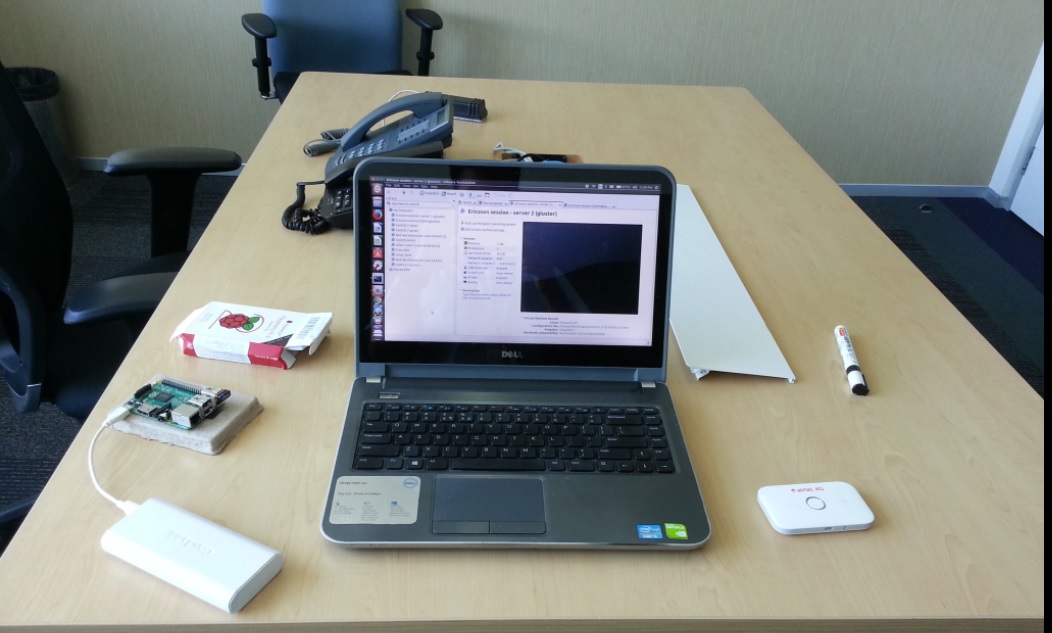on
Glusterfs -high available redundant storage with Raspberry pi/Centos server
Overview
This post is about how to create a high available redundant storage (Glusterfs replicated volume) from Raspberrypi and a centos server. This is just for fun project, which i am experimenting with my new raspberrypi 2 device. This is not a perfect setup, like i am using a 2 nodes replicated volume without quorom,created brick from ext3 filesystem and on root directory etc.Do not use this setup in production 🙂
Architecture
In this i am using a wifi hotspot router, to act as a DHCP server and connected both the raspberrypi device (server1.vikki.in) using wifi adapter(Edimax 150 Mbps Wireless Nano USB Adaptor) and a laptop running 2 VM’s ( server2.vikki.in and client.vikki.in)in same wireless network (192.168.1.0)
For details about how to enable wifi interface in raspberrypi please go through the Link
Softwares used
Ubuntu 14.04
Centos 6.3
Raspbian wheezy
Glusterfs 3.7
Hardware used
Raspberry PI Model 2 – 1GB
Edimax 150 Mbps Wireless Nano USB Adaptor (EW-7811Un)
Cenda T-50 Power Bank 10000 mAh
sandisk ultra 16gb memory card
Wifi router
Laptop
Installation
Step 1 :
Login to Raspberry pi and run the below command to install glusterfs
root@raspberrypi:~# sudo apt-get install glusterfs-serverStep 2 :
Login to the centos VM and do the following.
Download the glusterfs version 3.2.7. Since raspbian OS comes wit 3.2.7 , i am downloading the same version to avoid any conflicts.
Note : I tried a combination of version 3.2.7 and the latest version that comes with redhat EPL , but this doesn’t work out (peer probe connection failed)
root@server2]# wget -c http://bits.gluster.com/pub/gluster/glusterfs/src/glusterfs-3.2.7.tar.gzNow download and install all the build dependencies
root@server2]# yum install flex automake autoconf libtool flex bison openssl-devel libxml2-devel python-devel libaio-devel libibverbs-devel librdmacm-devel readline-devel lvm2-devel glib2-devel userspace-rcu-devel libcmocka-devel libacl-develExtract the source file, navigate and do configure
[root@server2 glusterfs-3.2.7]# ./configureGlusterFS configure summary
===========================
FUSE client : yes
Infiniband verbs : yes
epoll IO multiplex : yes
argp-standalone : no
fusermount : no
readline : yes
georeplication : yesAnd the finally make and install the gluster
[root@server2 glusterfs-3.2.7]# make
[root@server2 glusterfs-3.2.7]# make installConfiguration
Login to raspberrypi and probe the centos server (server2.vikki.in)
server1 :
root@raspberrypi:~# gluster peer probe server2.vikki.in
Probe successfulCheck the peer status
server1 :
root@raspberrypi:~# gluster peer status
Number of Peers: 1
Hostname: server2.vikki.in
Uuid: 0531327f-1b4a-4694-b525-58b7277472fd
State: Peer in Cluster (Connected)Similarly login to the centos server and probe the raspberry pi server(server1.vikki.in)
server2 :
root@server2 glusterfs]# gluster peer probe server2.vikki.in
Probe successfulserver2 :
root@server2 glusterfs]# gluster peer status
Number of Peers: 1
Hostname: server1.vikki.in
Uuid: 0531327f-1b4a-4694-b525-58b7277472fe
State: Peer in Cluster (Connected)I have a brick /share1 of 1GB size mounted in both raspberrypi and centos server
Now create a replicated volume from any of the server . Here i am creating it from the raspberry pi server(server1.vikki.in)
server1 :
root@raspberrypi:/var/log/glusterfs# gluster volume create replicated_volume replica 2 server1.vikki.in:/share1 server2.vikki.in:/share1Creation of volume replicated_volume has been successful. Please start the volume to access data.
Now start the replicated volume
server1 :
root@raspberrypi:/var/log/glusterfs# gluster volume start replicated_volume
Starting volume replicated_volume has been successfulCheck the replicated volume info
[root@server2 glusterfs]# gluster volume info replicated_volumeVolume Name: replicated_volume
Type: Replicate
Status: Started
Number of Bricks: 2
Transport-type: tcp
Bricks:
Brick1: server1.vikki.in:/share1
Brick2: server2.vikki.in:/share1Now the replicated volume is created . Login to the client (client.vikki.in) and mount the glusterfs volume
Client :
[root@client ~]# mount.glusterfs server1.vikki.in:/replicated_volume /mnt/gluster/The replicated volume is successfully mounted in the client
[root@client gluster]# df -h
Filesystem Size Used Avail Use% Mounted on
/dev/sda2 18G 3.5G 14G 21% /
tmpfs 495M 88K 495M 1% /dev/shm
/dev/sda1 291M 33M 244M 12% /boot
server1.vikki.in:/replica_volume
985M 18M 917M 2% /mnt/glusterTesting
create some files in gluster volume
[root@client gluster]# echo “when both nodes are running” > file1.txt
[root@client gluster]#ls
file1.txtNow go to both the server (raspberrypi,centos) and check the individual brick.
[root@server1 glusterfs]# ls /share1
file1.txt
[root@server2 glusterfs]# ls /share1
file1.txtNow we can see the files are replicated in both the nodes .
Now bring down one of the server and check if the gluster volume is still accessible in client.
My setup:

Discussion and feedback